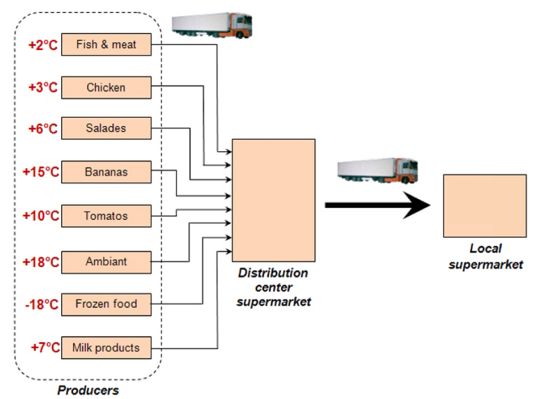You are here: English > Cold Chain > Food cold chain
 The cold chain of food products can be very complicated and complex. Temperature sensitive food products are very fragile in which even small temperature fluctuations can have a direct visual or taste or even disease effect. This is the reason why food, as being consumer goods, is so strictly protected by law. Another reason for the complexity of a cold chain of food products is the variety of products. A local supermarket for example has a lot of products which are not only temperature sensitive but also have a different temperature which means that multiple cold chains need to be created in order to keep each different product on its required temperature and within its temperature limits or barrier in order to guaranty the quality of the product.
The cold chain of food products can be very complicated and complex. Temperature sensitive food products are very fragile in which even small temperature fluctuations can have a direct visual or taste or even disease effect. This is the reason why food, as being consumer goods, is so strictly protected by law. Another reason for the complexity of a cold chain of food products is the variety of products. A local supermarket for example has a lot of products which are not only temperature sensitive but also have a different temperature which means that multiple cold chains need to be created in order to keep each different product on its required temperature and within its temperature limits or barrier in order to guaranty the quality of the product.
This all makes that the cold chain or temperature controlled supply chain of food products is very complex. All the actors in the cold chain who handle the food products like producers, distribution centers, transport companies, retailers and resellers, etc… have to take a lot of measurements to maintain the temperature of each product. Another big item in the cold chain of food products is the hard competition. In each town you can find a number of different supermarkets which compete with prices. Therefore all the actors in the cold chain are pressured to deliver the products at the best price and quality.
Active or passive cooling in a food cold chain
When temperature sensitive food products as chilled or fresh products, frozen products, heated products etc… are distributed in a cold chain, each actor in the cold chain as producers, transport companies, resellers and retailers etc… can choose which type of cooling technique they implement to maintain the required temperature of the product. This can be an active or passive cooling. If we talk about an active cooling we mean that a mechanical or electrical cooler engine is cooling the air that is surrounding the products creating a temperature controlled environment. The disadvantage of an active cooling system is that the cooling unit can only produce one temperature and that a number of CCP’s (Critical Control Points) will appear where the temperature can fluctuate. This fluctuation of the temperature appears at overload procedures as by loading and unloading the trucks, opening doors etc. Another cooling technique is passive cooling where an insulation material is used to insulate the products in group or individually so they are protected against unwanted external or outer temperatures. This gives the advantage that each different product or product group is protected so different products can be transported or stored in the same truck or room. Which of both types of cooling is used is depending on a number of items like costs and prices, logistic processes, temperature preservations etc. Seeing the big advantages of passive cooling more and more companies are implementing a combination of active and passive cooling so the cold chain can be closed totally and the quality of the products can be guaranteed.
Temperature conditioning in the distribution center
After the different food products have been delivered by the producer or import company to the distribution centers or resellers, they need to be distributed to the local stores. As said before, the local supermarket has a lot of temperature sensitive food products so the distribution center has to develop the best and most ideal way to get all the products to the stores. Below a drawing is shown which gives an overview of the most important product or temperatures groups which need to be transported to the local stores.

The drawing above shows a typical cold chain of temperature sensitive food products. These are only a few of the many different products that the supermarkets are receiving and distributing day by day. The question on this all is how the distribution can be done with such different products and temperature ranges. The first thing which is done is dividing the temperature ranges in categories being chilled = +5°C to +7°C, deep chilled = 0°C to +2°C, warm = +15°C, frozen = -18°C and ambient +18°C. This reduces the ranges to 5 groups which is still a lot knowing that these conditions need to be kept at the storage location in the distribution center and on the trucks which are distributing the goods. In the distribution center the temperature can easily be kept with separate cooling rooms or cool chambers in which the required temperature is generated. The problem in the distribution center starts at the loading platform where the goods are loaded and where all the goods are placed together in one room. This is a CCP (Critical Control Point), in the cold chain where the temperatures can fluctuate. The question in this is how big this CCP is and what the impact will be on the quality of the temperature sensitive goods. A said in previous points, passive cooling systems could be used to tackle these CCP’s where insulation materials are used to protect each product group individually protecting the temperature of the product against external temperatures.
Temperature conditioning in the truck / trailer
To distribute the five different temperature groups to the local stores, two different kind of transports can be used being a truck with one single temperature driving to all the stores delivering only one temperature group or one truck with several temperature controlled compartments, also called a bi-temp or multitemp trailer driving to just one or two stores delivering goods of different temperature groups. Seeing the cost issue more and more supermarkets are implementing a multi-temp transport system so they can drive with all the goods to just one store. In this multi-temp system also passive cooling is used on pallet base or roller container base. In this matter a thermo cover is pulled over a pallet or roller container, filled with a specific group of temperature sensitive goods, protecting them against the external temperatures. In this way the supermarket can transport more different temperatures on only one truck and get more flexibility on their logistics and distribution.




